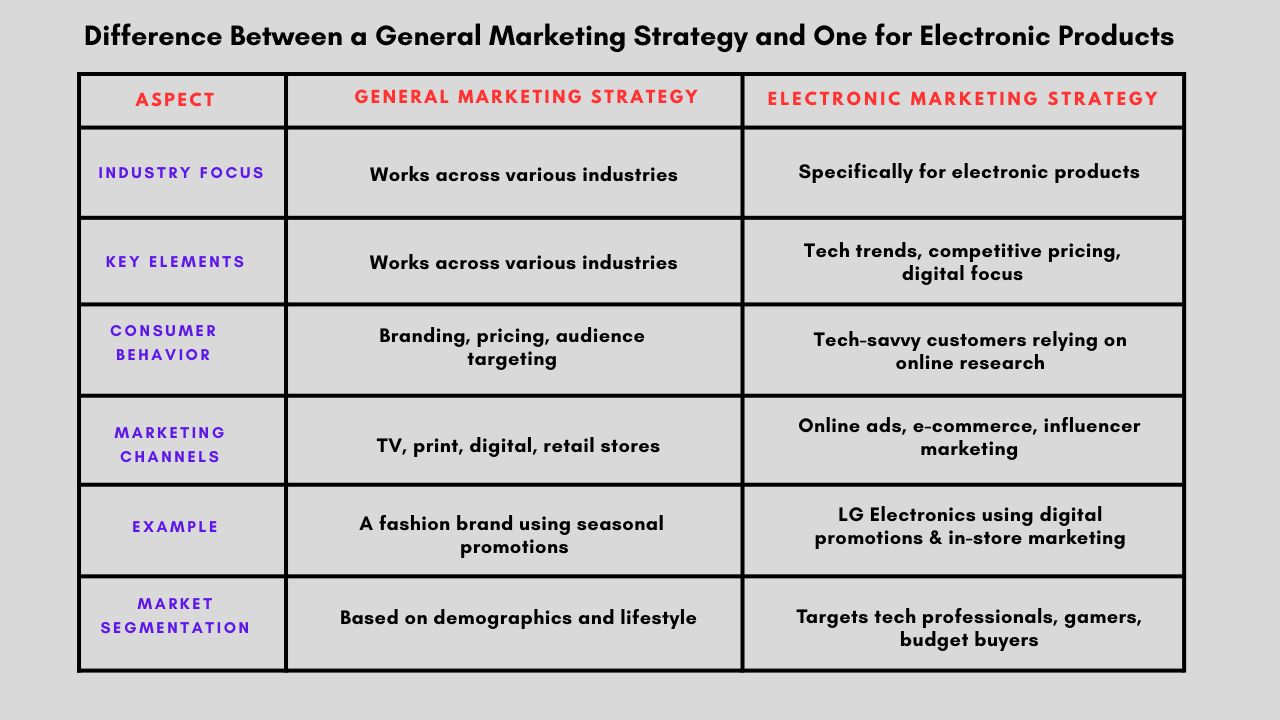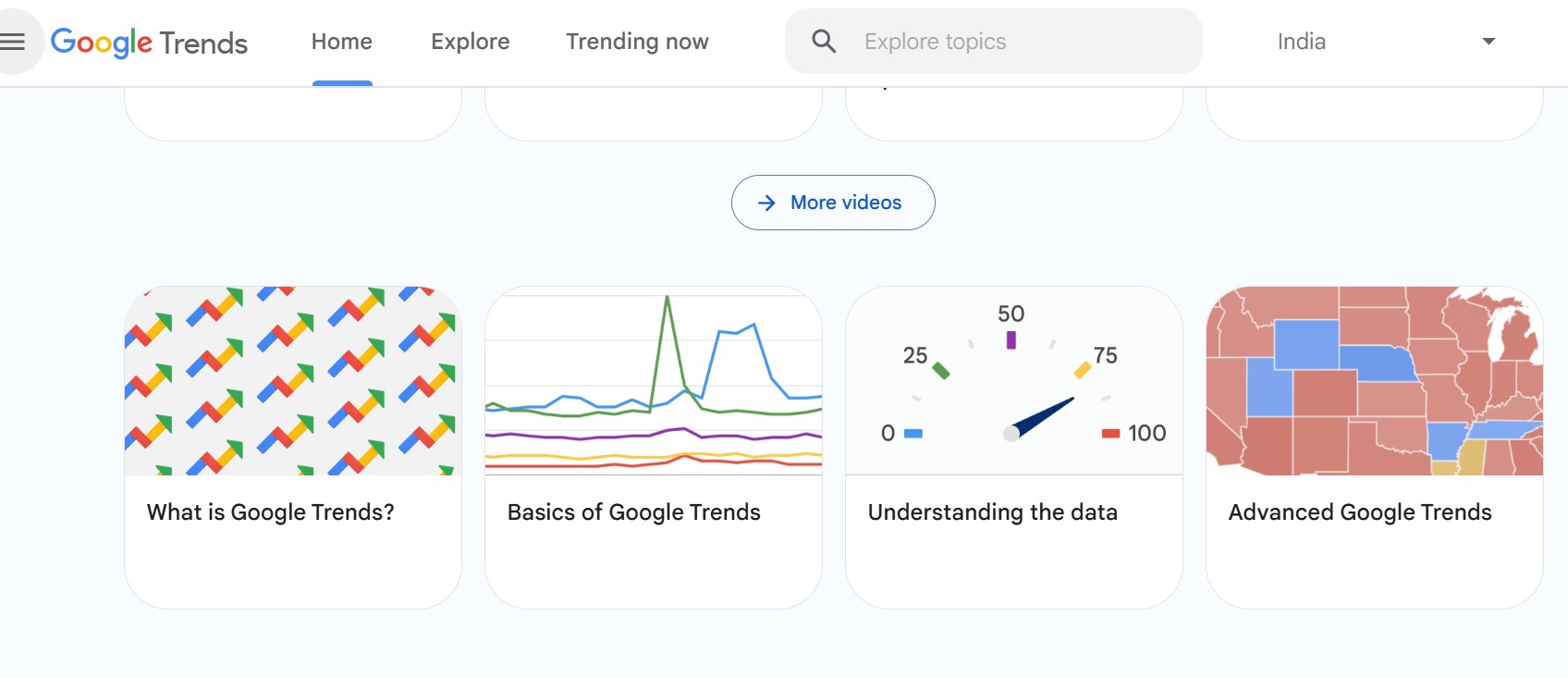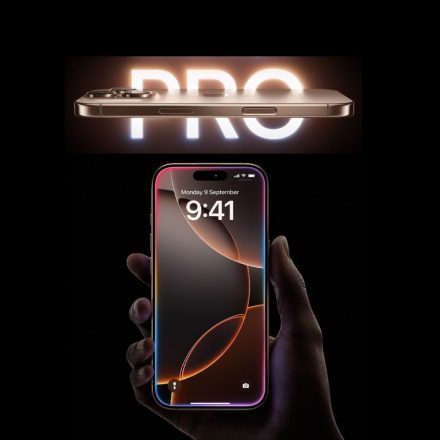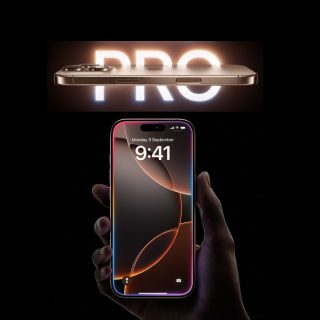Electronic marketing strategies are crucial for businesses to succeed in the fast-changing tech industry. A well-planned electronic marketing strategy helps brands get noticed, reach the right customers, and increase sales.
Understanding electronics marketing is important for long-term success in this competitive market.
What is the Marketing Strategy for Electronic Products?
An electronic marketing strategy is a planned way to promote electronic products using both online and offline methods.
It includes electronics marketing techniques like SEO, social media, influencer partnerships, and paid ads to connect with the right customers. Big brands like Apple and Samsung use smart marketing strategies for electronic products to strengthen their brand image.
A strong marketing strategy for electrical products helps businesses stay ahead by understanding customer needs, setting the right prices, and picking the best ways to sell their products.
Also, market segmentation for electronic products allows brands to focus on specific customer groups, increasing engagement and sales.
Let’s learn why a marketing strategy is crucial for the success of an electronic product.
Why is It Crucial for Success in the Competitive Tech Industry?
The electronics industry changes fast, so electronic marketing strategies are crucial for businesses to stay competitive. A well-planned electronics marketing approach helps brands get noticed, build loyal customers, and increase sales.
Companies like LG have used an electronic marketing strategy to grow their market share.
Additionally, the marketing strategy of LG Electronics is a great example of how brands can use digital tools to keep up with changing customer preferences.
Businesses that don’t invest in strong marketing strategies for electronic products risk falling behind in this crowded market.
Understanding Electronic Marketing Strategies for Electronic Products
Definition and Key Concepts in Electronics Marketing
An electronic marketing strategy is a step-by-step plan that businesses follow to promote electronic products using both online and offline methods.
Unlike general marketing, electronics marketing focuses on new technology, short product life cycles, and changing customer needs.
Important parts of marketing strategies for electronic products include:
- Market segmentation for electronic products
- Brand positioning
- Multiple marketing channels
Big brands like LG and Apple use advanced digital tools, like AI-based personalization and influencer marketing, in their marketing strategy for electrical products.
These strategies help them attract more customers and build stronger connections with their audience.
Difference Between a General Marketing Strategy and One for Electronic Products
A general marketing strategy works for different industries, focusing on branding, pricing, and reaching the right audience.
However, an electronic marketing strategy is designed specifically for electronics marketing, where companies must keep up with fast-changing technology, competitive pricing, and customers who rely on online research.
For example, the marketing strategy of LG Electronics combines both online and in-store marketing to attract tech-savvy buyers, using smart product launches and digital promotions.
Also, market segmentation for electronic products helps brands target different customer groups—like premium models for professionals or budget-friendly options for everyday users.

Core Elements of a Strong Electronic Marketing Strategy
A successful electronic marketing strategy relies on key components that help brands stand out in a competitive market.
From market research to strategic promotional efforts, companies must integrate the right tactics to drive visibility, engagement, and sales.
Here are the core components:
Market Research & Consumer Insights – Understanding Demand and Trends
Effective electronics marketing starts with thorough market research and analysis of consumer behavior. Identifying trends, tracking competitor strategies, and understanding market segmentation for electronic products help businesses tailor their offerings.
For instance, the marketing strategy of LG Electronics includes studying regional preferences to introduce customized product lines.
Brands also rely on AI-powered analytics and consumer feedback to refine their electronic marketing strategies and predict shifts in demand.
Brand Positioning & Unique Selling Proposition (USP) – Differentiating in the Market
A compelling electronic marketing strategy highlights a brand’s Unique Selling Proposition (USP) to create a lasting impression.
Whether it’s Apple’s focus on sleek design and innovation or Samsung’s cutting-edge display technology, successful marketing strategies for electronic products emphasize differentiation.
Building a strong brand image through storytelling and consistent messaging fosters customer loyalty and enhances market positioning.
Pricing Strategy – Competitive vs. Premium Pricing Models
Pricing plays a critical role in marketing strategies for electronic products. Companies can choose between:
- Competitive pricing – Offering budget-friendly options to attract a larger audience, common in mid-range electronic products.
- Premium pricing – Positioning products as high-end, as seen in Apple’s strategy for flagship devices.
A well-structured electronic marketing strategy balances pricing with perceived value, ensuring profitability while appealing to the target market.
Distribution Channels – Online Marketplaces, Brand Websites, Retail Partnerships
A brand’s success depends on efficient distribution channels that ensure accessibility and convenience.
Today, a mix of online marketplaces, brand websites, and retail partnerships plays a crucial role in electronics marketing.
- Online marketplaces like Amazon and Best Buy drive global sales.
- Brand websites enhance direct-to-consumer engagement, helping brands control their image.
- Retail partnerships boost in-store experiences, allowing consumers to test products before purchase.
By integrating these channels, companies optimize their electronic marketing strategy for maximum reach and sales.
Promotional Strategies – Paid Ads, Influencer Collaborations, Experiential Marketing
To capture consumer attention, brands leverage a mix of promotional strategies, including:
- Paid advertising – Targeted ads on Google, Facebook, and Instagram.
- Influencer marketing – Tech influencers showcasing gadgets on YouTube and TikTok.
- Experiential marketing – Live product demos, interactive events, and AR/VR experiences.
For example, the marketing strategy of LG Electronics includes immersive experiences, such as showcasing smart TVs at tech expos, which align with consumer preferences and technological advancements.
By integrating these elements, brands can craft electronic marketing strategies that drive growth, engagement, and long-term success in a highly competitive market.
Importance of an Electronic Marketing Strategy in Business Growth
A well-executed electronic marketing strategy helps brands enhance visibility, build customer trust, and stay ahead of shifting market trends.
- Enhancing Brand Awareness and Customer Trust
Brand recognition is key in electronics marketing, where consumers are constantly introduced to new innovations.
Companies like Apple and Samsung use targeted electronic marketing strategies to reinforce their brand identity through digital ads, content marketing, and influencer collaborations.
A strong marketing strategy for electrical products also builds credibility. Consumers rely on online reviews, expert recommendations, and product demonstrations before purchasing. Leveraging these tools enhances trust and strengthens brand reputation.
- Driving Customer Engagement and Loyalty in a Tech-Driven Market
In today’s digital world, an effective electronic marketing strategy fosters meaningful interactions with customers.
Personalized email campaigns, interactive social media content, and AI-driven chatbots ensure seamless communication, leading to higher customer retention.
The marketing strategy of LG Electronics includes loyalty programs and customer engagement initiatives, ensuring long-term brand-consumer relationships.
Companies that continuously engage their audience through marketing strategies for electronic products gain a competitive edge in customer loyalty.
- Increasing Sales and Adapting to Market Trends
A dynamic electronic marketing strategy directly influences sales and revenue growth. Businesses that understand market segmentation for electronic products can tailor promotions to specific customer groups, maximizing conversions.
Additionally, evolving consumer behaviors demand adaptability. Brands must continuously refine their marketing strategies for electronic products by leveraging analytics and emerging digital tools to stay relevant and profitable.
By implementing a strategic electronics marketing plan, businesses can drive sustainable growth and maintain a strong market presence.
Types of Marketing Strategies for Electronic Products
A well-rounded electronic marketing strategy incorporates multiple approaches to maximize reach and engagement. Businesses leverage digital marketing, traditional marketing, and niche strategies to enhance visibility, build trust, and drive sales.
Digital Marketing – SEO, Content Marketing, PPC, Social Media Ads
Digital marketing is at the core of modern electronics marketing, allowing brands to connect with tech-savvy consumers. Key tactics include:
- SEO (Search Engine Optimization): Optimizing websites and product pages for search engines ensures better visibility. Brands like Samsung use SEO-driven content to rank for searches related to marketing strategies for electronic products.
- Content Marketing: Blogs, product guides, and video reviews help educate customers. The marketing strategy of LG Electronics includes detailed product tutorials and comparison articles.
- PPC (Pay-Per-Click) Advertising: Google Ads and social media campaigns target specific audiences, increasing conversions.
- Social Media Advertising: Platforms like Instagram, YouTube, and Facebook drive engagement through targeted ads and influencer partnerships.
By integrating these strategies, companies create a robust electronic marketing strategy that enhances brand awareness and customer engagement.
Traditional Marketing – TV Commercials, Print Ads, Retail Marketing
Despite the digital shift, traditional marketing remains relevant in electronics marketing, particularly for premium product launches and brand positioning.
- TV Commercials: Companies use high-quality advertisements to showcase innovation, such as LG’s OLED TV campaigns.
- Print Advertising: Magazines and newspapers still play a role in reaching older demographics and professionals interested in electronic products.
- Retail Marketing: In-store promotions, product demos, and exclusive launch events create hands-on experiences that drive sales.
For high-end gadgets, combining electronic marketing strategies with traditional methods ensures a broader reach.
Niche Strategies – Growth Hacking, Influencer Collaborations, Experiential Events
To stand out in a crowded market, brands explore niche marketing strategies for electronic products, such as:
- Growth Hacking: Using data-driven techniques to accelerate customer acquisition, often through viral campaigns or referral programs.
- Influencer Collaborations: Tech influencers on YouTube and Instagram drive massive engagement by reviewing and promoting gadgets.
- Experiential Marketing: Brands create immersive events where customers can interact with products, such as virtual reality demos or pop-up stores.
By implementing a mix of digital, traditional, and niche approaches, companies develop a strong electronic marketing strategy that ensures long-term success in the fast-paced electronics industry.
Tools & Technologies for Effective Electronics Marketing
Implementing the right tools is crucial for optimizing an electronic marketing strategy. From analytics tools to AI-driven marketing, businesses can enhance their electronics marketing efforts by leveraging technology to track performance, automate processes, and personalize customer experiences.
Analytics Tools – Google Analytics, SEMrush for Tracking Performance
Data-driven decision-making is a key component of marketing strategies for electronic products. Analytics tools help brands measure campaign effectiveness and optimize their strategies.
- Google Analytics tracks website traffic, customer demographics, and conversion rates, helping brands refine their electronic marketing strategies.
- SEMrush provides insights into SEO performance, competitor analysis, and keyword trends, ensuring businesses rank higher in search results for terms like electronic marketing strategy and market segmentation for electronic products.

By using these tools, companies can make data-backed improvements to their electronics marketing campaigns.
Social Media & Automation – Hootsuite, Buffer, Mailchimp for Engagement
Managing multiple digital platforms is essential for a streamlined electronic marketing strategy. Social media and automation tools help businesses maintain consistency and efficiency.
- Hootsuite & Buffer schedule and manage social media posts across platforms like Facebook, Instagram, and LinkedIn, ensuring continuous brand presence.

- Mailchimp automates email marketing campaigns, allowing businesses to nurture leads and engage customers with product updates and promotions.
These tools improve engagement and ensure that marketing strategies for electronic products remain effective.
AI-Driven Marketing – Chatbots, Personalization Tools for Customer Experience
AI-powered tools enhance the marketing strategy for electrical products by offering personalized customer experiences.
- Chatbots provide instant customer support, improving response times and engagement.
- AI personalization tools recommend products based on browsing history, increasing conversion rates.
By integrating these advanced technologies, brands can create an efficient, data-driven electronic marketing strategy that enhances customer satisfaction and business growth.
Step-by-Step Guide to Creating an Effective Electronic Marketing Strategy
A successful electronic marketing strategy requires a structured approach, from setting clear goals to continuously optimizing campaigns.
This guide outlines the essential steps to build a results-driven marketing strategy for electrical products that aligns with market trends and consumer demands.
1. Identify Marketing Goals and Target Audience
Setting clear objectives is the foundation of an effective electronic marketing strategy. Companies should define key performance indicators (KPIs) such as brand awareness, customer acquisition, and sales growth.

Equally important is market segmentation for electronic products—categorizing consumers based on demographics, preferences, and purchasing behavior.
For instance, gaming laptops target tech-savvy professionals, while budget smartphones appeal to price-conscious customers. Understanding these segments ensures tailored electronics marketing efforts.
2. Conduct Competitor and Market Analysis
Analyzing competitors helps brands refine their marketing strategies for electronic products. Businesses can use tools like SEMrush and Google Trends to track competitors’ SEO performance, ad campaigns, and product positioning.

Market analysis also involves identifying consumer trends. The marketing strategy of LG Electronics, for example, evolves based on shifts in smart home technology and sustainability trends.
By studying market demands, brands can develop products and campaigns that resonate with their audience.
3. Develop Strong Branding and Messaging
A compelling brand identity differentiates products in the competitive electronics marketing space. Establishing a Unique Selling Proposition (USP), such as Apple’s premium design or Bose’s superior sound quality, strengthens consumer perception.
Messaging should align with customer needs, highlighting key benefits through website content, social media, and advertisements.

Successful electronic marketing strategies focus on delivering a consistent brand voice across all channels.
4. Choose the Right Marketing Mix (4Ps)
The 4Ps framework—Product, Price, Place, and Promotion—guides the execution of a strong electronic marketing strategy:
- Product – Ensure product features meet customer demands, such as high-resolution displays for TVs or extended battery life for smartphones.
- Price – Implement a pricing strategy based on market positioning (premium, budget, or competitive pricing).
- Place – Optimize distribution channels, leveraging online marketplaces, brand websites, and retail stores.
- Promotion – Use a mix of digital marketing (SEO, PPC, social media ads) and traditional marketing (TV commercials, retail promotions) to maximize reach.
By balancing these elements, brands enhance visibility and sales in electronics marketing.
5. Implement Campaigns and Track Performance
Launching targeted campaigns is a crucial step in executing a marketing strategy for electrical products. Companies should:
- Run social media and PPC campaigns to drive traffic.
- Collaborate with tech influencers to boost engagement.
- Utilize email marketing for customer retention.
Tracking campaign performance using Google Analytics, SEMrush, and Hootsuite ensures brands can measure ROI and make data-driven adjustments.
6. Optimize Strategies Based on Analytics and Customer Feedback
A strong electronic marketing strategy is always evolving. Businesses must analyze customer feedback, sales reports, and competitor activity to refine their marketing efforts.

For example, the marketing strategy of LG Electronics includes real-time consumer feedback analysis, allowing them to improve product features and advertising tactics.
By continuously optimizing their approach, companies can ensure long-term success in the fast-paced electronics marketing industry.
Case Studies: Successful Electronic Product Marketing Strategies
Examining real-world electronic marketing strategies provides insights into how top brands drive sales and brand loyalty. Companies like Apple, Samsung, and Tesla have revolutionized electronics marketing through unique approaches.
Their success demonstrates the power of brand positioning, influencer marketing, and direct-to-consumer engagement.
Apple’s Brand-Driven Marketing Approach
Apple’s marketing strategy for electronic products focuses on premium branding, minimalistic messaging, and customer loyalty. The company has built a strong brand identity that emphasizes innovation, sleek design, and a seamless user experience.
Key tactics include:
- Emotional branding: Apple’s ads focus on how products improve lives rather than just features.
- Product launches as events: Apple creates excitement through highly anticipated launch events, live-streamed globally.
- Ecosystem lock-in: Exclusive compatibility across Apple devices increases brand loyalty and repeat purchases.
Apple’s strategy aligns with a premium electronic marketing strategy, ensuring high demand for its products.
Samsung’s Influencer and Experiential Marketing Campaigns
Samsung combines influencer marketing, experiential marketing, and digital ads to create a dynamic electronics marketing approach.
Key elements of Samsung’s marketing strategies for electronic products:
- Influencer Collaborations: Samsung partners with top YouTubers and tech influencers to showcase product features.
- Experiential Marketing: Interactive pop-up stores allow customers to test products before buying.
- Retail and Digital Integration: Samsung leverages both online and offline channels for maximum reach.
The company’s market segmentation for electronic products ensures targeted campaigns for premium, mid-range, and budget consumers, strengthening its global presence.
Tesla’s Direct-to-Consumer Digital Strategy
Tesla’s electronic marketing strategy is unique because it eliminates traditional dealerships and sells directly to consumers.
Key elements of Tesla’s marketing strategy for electrical products:
- No paid advertising: Tesla relies on social media, word-of-mouth, and Elon Musk’s personal branding.
- Online-only sales model: Tesla’s website handles all purchases, enhancing convenience.
- Viral marketing and PR: Musk’s tweets and Tesla’s futuristic product launches generate organic hype.
This direct approach sets Tesla apart in electronics marketing, reducing costs and maximizing customer engagement.
These case studies highlight diverse electronic marketing strategies, demonstrating how tailored approaches drive long-term success.
Common Challenges in Marketing Electronic Products
The electronics marketing industry faces unique obstacles due to rapid innovation, intense competition, and ever-evolving consumer expectations. Businesses must continuously adapt their electronic marketing strategies to stay ahead.
Here are some major challenges in the marketing strategy for electrical products and how brands can overcome them.
1. Short Product Life Cycles and Rapid Technological Advancements
The electronics industry evolves rapidly, with new models and upgrades launching frequently. As a result, brands must:
- Keep pace with innovation – Companies like Apple and Samsung invest heavily in R&D to introduce cutting-edge features.
- Strategize product launches – Limited-edition releases and pre-launch promotions create urgency and demand.
- Manage inventory effectively – Overstocking outdated models leads to losses, while understocking can result in missed sales.
An agile electronic marketing strategy ensures products remain relevant amid changing consumer preferences.
2. High Competition and Pricing Pressures
The market is flooded with competing brands, making differentiation a challenge in marketing strategies for electronic products. Pricing wars can reduce profit margins, particularly in budget and mid-range segments.
To stay competitive, brands should:
- Focus on value rather than price – Apple’s premium pricing works because of its strong brand image and exclusive ecosystem.
- Use smart pricing strategies – Companies can leverage bundle deals, trade-in programs, and installment plans.
- Differentiate through marketing – Unique branding, storytelling, and personalized offers set products apart.
A strong marketing strategy for electrical products should emphasize product quality, innovation, and brand trust.
3. Managing Customer Expectations, Product Reviews, and Brand Reputation
Consumer trust plays a crucial role in electronics marketing, with online reviews and word-of-mouth impacting purchasing decisions. Negative feedback can quickly harm a brand’s image.
To maintain a strong reputation, brands must:
- Engage with customers actively – Responding to queries and complaints on social media builds trust.
- Encourage user-generated content – Positive reviews, testimonials, and unboxing videos enhance credibility.
- Deliver consistent product quality – Samsung and LG prioritize rigorous quality testing to minimize recalls and complaints.
A proactive electronic marketing strategy focused on customer satisfaction and brand loyalty ensures long-term success.
A strong electronic marketing strategy is essential for success in the competitive electronics marketing industry. Businesses must build an effective marketing strategy for electrical products, companies should:
- Understand consumer behavior and segment markets effectively.
- Leverage digital and traditional marketing to maximize reach.
- Continuously optimize strategies based on analytics and feedback.
Future Trends in Electronics Marketing
The future of electronics marketing will be shaped by emerging technologies:
- AI-driven personalization – AI will enhance customer experiences with chatbots, predictive analytics, and tailored recommendations.
- AR/VR experiences – Virtual try-ons and interactive demos will redefine online shopping.
- Sustainability-driven marketing – Consumers are prioritizing eco-friendly products, making green initiatives a key differentiator.
Refine your electronic marketing strategies to stay ahead in the fast-paced industry. Embrace digital trends and connect with your customers today!


















Leave a Comment